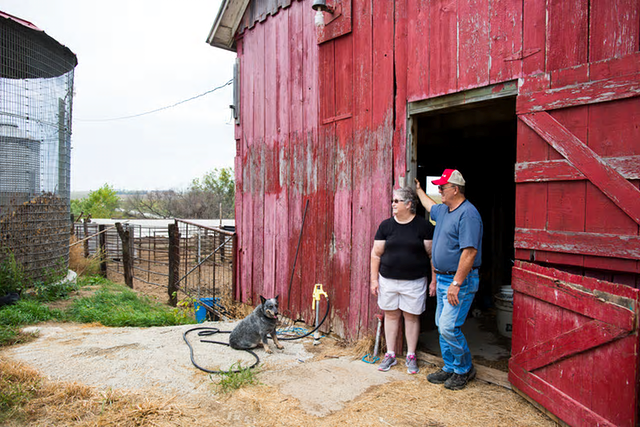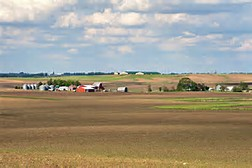“In the last 25 to 30 years, there’s not a day that goes by that I don’t think about suicide” farmer John Blaske confided to Dr. Rosmanm during their first conversation.
he September sky is chalk gray, and for a moment it rains. John Blaske’s cows are lined up at the fence; cicadas trill from the trees. It’s been a year since he flipped through Missouri Farmer Today and froze, startled by an article written by Rosmann.
“Suicide death rate of farmers higher than other groups, CDC reports,” the headline read.
“I read it 12 or 15 times,” Blaske says, sitting next to his wife Joyce at the kitchen table. “It hit home something drastically.”
In the house, every square inch of wall or shelf space is filled with memorabilia and photos of their six children and 13 grandchildren. Music croons softly from the kitchen radio.

John and Joyce Blaske
For Blaske it all started when a devastating fire wiped out most of his land, leaving him struggling to provide for his family.
For a farmer, loss of land often cuts deeper than a death, something Blaske understands firsthand. On Thanksgiving Day in 1982, a spark shot out from Blaske’s woodstove to a box of newspaper. The fire climbed curtains, melted doors, burned most of the house. The Blaskes became homeless.
Soon after the fire, the farm crisis intensified. The bank raised their interest rate from seven to 18%. Blaske raced between banks and private lenders, attempting to renegotiate loan terms. Agreements would be made and then fall through. “They did not care whether we had to live in a grader ditch,” remembers Blaske.
Desperate, the family filed for bankruptcy and lost 265 acres. For the first time, Blaske began to think of suicide.
It still haunts him to this day and takes him back to a dark place every time he thinks of these hard times.
Much of the acreage lost to the Blaskes sits across the road from the 35 acres they retain today. “I can’t leave our property without seeing what we lost,” Blaske frets. “You can’t imagine how that cuts into me every day. It just eats me alive.”
But, John Blaske also took the initiative to push past his comfort zone and find solutions, after seeing the article by Rosmann in the paper about farmer suicide rates AND that there were answers!
After finding the article in Missouri Farmer Today, John Blaske decided to contact Rosmann. But the article listed a website, and the Blaskes did not own a computer. So he drove to the library and asked a librarian to send an email to Rosmann on his behalf. A few days later, as Blaske was driving his tractor down the road, Rosmann called him back.
“He wanted to hear what I had to say,” Blaske says. “Someone needs to care about what’s going on out here.”
Which is difficult as besides Rosmann and a few other select souls carrying the torch not a lot of outside solutions exists.
Since the 1980s farm crisis, Rosmann says experts have learned much more about how to support farmers. Confidential crisis communication systems – by telephone or online – are effective, but staff need to be versed in the reality and language of agriculture. “If you go to a therapist who may know about therapy but doesn’t understand farming, the therapist might say, ‘Take a vacation – that’s the best thing you can do.’ And the farmer will say, ‘But my cows aren’t on a five-day-a-week schedule.’”
Affordable therapy is critical and inexpensive to fund – Rosmann says many issues can be resolved in fewer than five sessions, which he compares to an Employee Assistance Program. Medical providers need to be educated about physical and behavioral health vulnerabilities in agricultural populations, an effort Rosmann is working on with colleagues.
As we touched on earlier in the piece Congress has yet to agree to fund such a proposal. But that is not to say private funding is out of the picture or that an army of volunteers cannot arise to assist with running crises hotlines.
Rosmann states in his academic mussing that farmers are,
“People engaged in farming,” he explains, “have a strong urge to supply essentials for human life, such as food and materials for clothing, shelter and fuel, and to hang on to their land and other resources needed to produce these goods at all costs.”
When farmers can’t fulfill this instinctual purpose, they feel despair. Thus, within the theory lies an important paradox: the drive that makes a farmer successful is the same that exacerbates failure, sometimes to the point of suicide. In an article, Rosmann wrote that the agrarian imperative theory “is a plausible explanation of the motivations of farmers to be agricultural producers and to sometimes end their lives”.
And is that not an urge worth protecting?
Source: The Guardian
Image: Edwin Dearborn


A Trump supporter calling someone ignorant
HAHAHA
Liberals, just when you think they can’t get any dumber they go and prove you wrong.
Probably could read whole article if stupid survival technics would stop sensoring it so I can’t read it. Thanks FB. I see again you do that want us to know the truth. Leave the articles alone.
I don’t think they are killing themselves I think they are being killed…
I don’t believe this headline at all.
Yes, it in infuriating to have the stupid ad pop up so you can’t read the entire article! Done on purpose so censor? I have complained about it several times but FB doesn’t take it down.
So American can import food from China, India and rest countries
INDIAN’S from India and many other countries farmers are doing the same thing. Government regulations of requirements of genetic altered seed to get more fruiting etc. And rules and regulations on how they are extorted to use what the government programs force ,are putting them into slavery and as servants. These seeds are sterile after the first crop and these folks are at the government’s mercy if they want to survive. This is the munipulation the government forces to get control of every citizen and their lands . No self sufficient citizen in the world is valuable because they must have the heel in their backs ,submission!
Praying for our Farmers.Hard working folks.
THIS IS LIBERAL PROPAGANDA